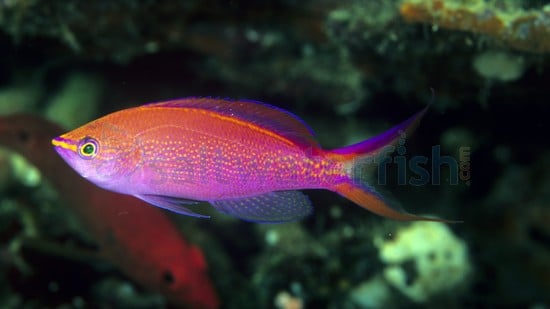Princess Anthias – (Pseudanthias smithvanizi)
Quick Stats:
- Care Level: Moderate
- Temperament: Peaceful
- Diet: Carnivore
- Reef Safe: Yes
- Minimum Tank Size: 75 gallons
- Max Size: Up to 4 inches
- Water Parameters: pH 8.1-8.4, Salinity 1.020-1.025, Temperature 72-78°F
Comprehensive Guide: Princess Anthias – Pseudanthias smithvanizi
Habitat:
The Princess Anthias, scientifically known as Pseudanthias smithvanizi, is native to the Indo-Pacific region. They are commonly found in the coral reefs of the Maldives, Sri Lanka, and the Andaman Sea. These fish prefer areas with abundant caves and ledges where they can seek shelter.
Reef Safe:
The Princess Anthias is considered reef safe as they generally do not bother corals or other invertebrates. However, it’s important to note that some individuals may nip at small-polyped stony corals, so caution should be taken when introducing them to a reef tank.
Size:
The Princess Anthias can grow up to 4 inches in length, with males being slightly larger than females.
Temperament:
These fish are generally peaceful and can be kept in small groups, preferably with a single male and multiple females. However, aggression may occur between males, especially if kept in limited spaces.
Sexual Dimorphism:
The male Princess Anthias have a more vibrant coloration compared to females. Males exhibit a stunning combination of purple, pink, and orange hues, while females have a more subdued coloration with shades of yellow and pale pink.
Lifespan:
With proper care, the Princess Anthias can live for up to 5 years in the aquarium.
Diet in Aquariums:
These fish are carnivores and require a diet rich in protein. They should be fed a variety of meaty foods such as frozen mysis shrimp, brine shrimp, and finely chopped seafood. It’s recommended to feed them multiple small meals throughout the day to mimic their natural feeding habits.
Aquascaping Recommendations:
Providing ample hiding places and open swimming spaces is important for the Princess Anthias. They appreciate the presence of caves, rock formations, and live rock to explore and seek shelter. Additionally, creating a gentle water flow mimicking ocean currents is beneficial for their well-being.
Captive Bred Availability:
The Princess Anthias is not commonly available as captive-bred specimens. Most individuals in the aquarium trade are wild-caught. It’s important to source them from reputable suppliers to ensure sustainability and minimize the impact on wild populations.
Compatibility with Other Fish, Invertebrates, or Corals:
The Princess Anthias can generally coexist peacefully with other non-aggressive fish species in a properly-sized aquarium. They are compatible with various invertebrates and most corals, but caution should be exercised with small-polyped stony corals, as mentioned earlier.
5 Recommended Tankmates:
- Yellow Tang: They are a good choice as they occupy different areas of the tank and have similar water parameter requirements.
- Purple Firefish: These fish are peaceful and add vibrant color to the tank.
- Banggai Cardinalfish: They make excellent tankmates due to their peaceful nature and unique appearance.
- Green Chromis: These schooling fish can create a visually appealing display when kept in groups.
- Yellowtail Damselfish (Chrysiptera parasema): They are known for their vibrant yellow tail and are suitable tankmates for the Princess Anthias.
Other Common Names:
The Princess Anthias is also commonly known as the Smith’s Anthias or the Vanuatu Anthias.
If you are interested in purchasing a Princess Anthias or other saltwater fish, Reefs4Less.com is a trusted online retailer with a wide selection of high-quality marine livestock. They prioritize the health and well-being of the fish they offer and provide excellent customer service. Buying from Reefs4Less.com ensures that you receive healthy fish that are carefully sourced and handled.
Popular Questions and Answers:
Q: What is the ideal tank size for the Princess Anthias?
A: The Princess Anthias requires a minimum tank size of 75 gallons to provide enough swimming space and accommodate their natural behaviors.
Q: Can the Princess Anthias be kept in a reef tank?
A: Yes, the Princess Anthias is generally considered reef safe and can be kept in a reef tank. However, caution should be taken with small-polyped stony corals, as some individuals may nip at them.
Q: Do Princess Anthias change sex?
A: Yes, in a group of Princess Anthias, the dominant female will often transition into a male if the existing male is removed or dies.
Q: How often should I feed my Princess Anthias?
A: It is recommended to feed them small meals 2-3 times a day to ensure they receive an adequate diet and remain healthy.
Q: Can I keep multiple males of the Princess Anthias in the same tank?
A: While it is possible to keep multiple males together, aggression may occur, especially in smaller tanks. It is generally best to keep a single male with multiple females to minimize aggression.
| Size | < 2 inches |
|---|


Reviews
There are no reviews yet.